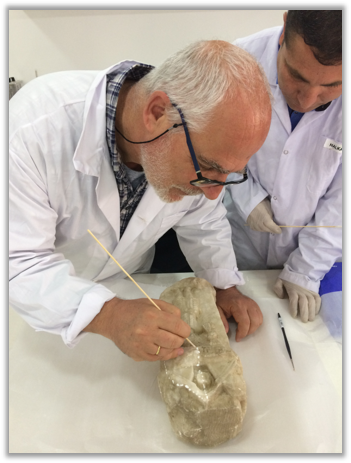Amelia International Conservation Studies
Restoration of Historic Monuments in Italy
No prerequisites required.
Student Learning Outcomes:
Students who successfully complete this course will be able to:
Identify various stones, mortars, cements, and other building materials, their use in architecture, their physical properties, and appropriate restoration methods.
Analyze materials and apply treatment methods to clean stone or brick surfaces.
Assess, recommend, and treat architectural surfaces by consolidating, cleaning/removing the inappropriate materials, filling the gaps such as mortaring and repointing, protecting and carrying out an esthetical treatment, where necessary.
Format:
Morning Lectures: Monday – Friday, 8:30 AM – 10:00 AM (4 weeks)
Classroom: Classes are held in the 14th century Franciscan Boccarini cloister. Sala Boccarini (Archaeological Museum of Amelia)
Lectures are mostly dedicated to the presentation of material and historical technologies, with some time for questions and answers. Three visiting lecturers will present various topics of interest to stone artifacts and historical building conservation.
Afternoon Workshop: Monday – Friday, 2:30 PM to 6:30 PM (4 weeks)
As part of the course, students will be working on our present field project:
Lapidarium of the Town Hall
There also will be an afternoon visit the Archaeological Museum in Amelia.
Grading:
Participation/Field work: Complete various assignments that are given as part of the field project (30%)
Dependent upon the project, these may include: treating stone with biocide, cleaning stone, consolidation of stone where necessary, removal of inappropriate mortars, pointing stone work with hydraulic lime mortars, protection treatment.Midterm Exam format: multiple choice test with 25 questions (35%)
Assignments: Term Paper: 5-page paper on a topic to be assigned (35%)
The paper will be evaluated on content, organization, and clarity.Late Assignment Policies
Unexcused late assignments will be marked down one-half letter grade. Students should discuss with the professor beforehand any reason for anticipated late submission and specify when submission will occur.
Fieldwork cannot be made-up.
Reading Materials for Professional Field Experience Historic Monument Restoration
Related Reading:
Eric Doehne, Stone Conservation: An Overview of Current Research (Second Edition), Clifford A. Price, 2010
ICOMOS International Scientific Committee for Stone (ISCS): Illustrated glossary on stone deterioration patterns XV.
Peter Rockwell, The Art of Stoneworking: A Reference Guide Hardcover – 25 Feb. 1994
Giorgio Torraca, Lectures on Materials Science for Architectural Conservation, The Getty Conservation Institute, 2009
Materials Required
Restoration of Historic Monuments in Italy
Instructor Prof. Luciana Festa
All this personal protective gear is required for all students taking part to this course:
a) thick work gloves
b) steel toe construction boots
c) safety goggles
Summary of Lecture Content
Natural Stones
Geological Formation
• Igneous rocks
• Sedimentary rocks
• Metamorphic rocks
Stone carving technology
• Materials
• Tools
• Working processes
• Traditional Uses in Architecture
• Traditional Uses in Art
Decay Processes
Porous structure
Water/Moisture
Frost and thaw cycles
Salts
Wind
Pollution
• Natural acidity of rain
• Rain in polluted atmosphere
• Condensation
• Black crusts
Biological growth (Bio-deterioration)
• Micro and macro organisms
• Chemical action (metabolism)
• Physical action
Oxalates
Anthropic causes
From natural stones: stone derivatives, “artificial stones ”: mortars, plasters.
Clay
• Raw
• Fired
Gypsum
• Historical notes
• Starting material
• Stable - meta-stable phases - setting and non setting gypsum
• How it is obtained
• How it reacts
• Its uses
Aerial lime
• Historical notes
• How it is obtained
• Cycle of lime
• Process of carbonation
• Properties
• Comparison between ancient and modern technology: slaking and seasoning
Hydraulic lime
• Historical notes
• Starting material
• How it is obtained
• Properties
Cement
• Natural cements
• Artificial cement
• Properties
• Negative effects on historical masonries
Aggregates
• Inert
Natural sands
Crushed stones
Hydraulic
• Natural
Pozzolana
• Artificial
Crushed bricks and others
Restoration, Conservation, Prevention
Restoration, curative conservation, preventive conservation, and maintenance
• Direct and indirect
• Principle of restoration:
• Minimum intervention
• Critical and technological approach
• Prevention is better than restoration
Steps of restoration
• Consolidation (stone and wall paintings)
• Joining parts
• Cleaning
Disinfection (not for aesthetical reasons, but implies aesthetical values)
Mechanical action (physical)
dry (scalpels, chisels, drills, sand-blasting, ultrasonic, laser, etc.)
wet (high pressure water spray)
Chemical-mechanical action (misting water spray)
Chemical/physical or chemical action (salt solutions, basis, acids)
• Filling gaps (not only for aesthetical reasons)
• Protection












